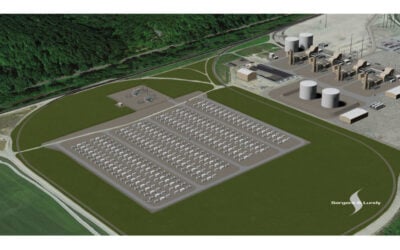
European Union (EU) reforms of electricity market design should recognise the value of flexibility options like energy storage, according to representatives of Fluence.
The EU yesterday opened a public consultation into its planned reformation, aimed at addressing vulnerabilities laid bare by last year’s energy crisis and the resulting soaring cost of consumer bills.
Enjoy 12 months of exclusive analysis
- Regular insight and analysis of the industry’s biggest developments
- In-depth interviews with the industry’s leading figures
- Annual digital subscription to the PV Tech Power journal
- Discounts on Solar Media’s portfolio of events, in-person and virtual
The reform process will also support the Union’s key energy and climate policies, including REPowerEU, its plan to increase energy independence from Russian fossil fuels and the European Green Deal, the package to support transition to a greenhouse gas (GHG) emissions-free economy by 2050.
“The EU’s electricity market has served us well for over 20 years. But the unprecedented energy crisis we are facing shows that we need to make the electricity market design fit for the future, allowing it to deliver the benefits of affordable clean energy to everyone,” Kadri Simson, EU commissioner for energy said.
In a recent technical paper contributed to our publisher Solar Media’s quarterly journal PV Tech Power (Vol.33), Fluence’s Julian Jansen and Lars Stephan wrote that the reforms must value flexibility from technologies such as energy storage and demand response as a “critical enabler of the energy transition”.
“European policy makers need to strengthen the role of flexibility technologies, including energy storage, in future Energy Market Design,” the pair wrote.
Jansen is growth and market development director and Stephan policy and market development director in the EMEA region for Fluence, a system integrator, manufacturer and provider of technologies for energy storage and energy trading and management services for renewables and storage.
The European energy crisis is not simply the result of gas shortages, but also of persistent heat waves which reduced the amount of water available for cooling conventional power plants and for generation from hydroelectric resources.
Unplanned outages at much of France’s nuclear fleet – a fleet often cited as an example of existing nuclear’s low-cost and low-carbon advantages – did not help either.
With the EU now targeting 45% renewable energy by 2030, equivalent to 1,236GW of renewables including 320GW of new solar PV, cumulative solar capacity alone will exceed the demand of several European nations, the authors pointed out.
‘Reforms must encourage investment and integration’
This throws up two major questions: how to incentivise and de-risk investment into the necessary technologies including transmission and interconnection between countries, and how to effectively integrate higher shares of renewables while matching supply of energy with demand.
If the Electricity Market Design process were to fail, the consequences would include congestion on power grids, curtailed renewable generation, higher costs to consumers and slowed progress on decarbonisation.
The suite of reforms proposed in Jansen and Stephan’s article include decarbonising the Capacity Mechanism (CM), the EU’s capacity market by which it ensures resource adequacy on the European grid’s national energy markets.
This could be achieved by measures like favouring low-carbon assets through higher payments and longer contract lengths and decreasing an existing cap over time to phase in decarbonisation of the CM. There have been a few movements in that direction in individual markets such as Italy, where grid operator TERNA has hosted a limited number of pilot auctions for low-carbon capacity resources.
Elsewhere, the authors also proposed creating market mechanisms that would allow flexibility options to compete based on their ability to balance generation with demand on the grid.
Two possible ways of doing that would be through introducing auctions for energy assets which would require bids to include renewable generation with energy storage, and Contracts for Difference (CfD) auctions to specifically procure flexibility and curtailment prevention resources.
“Europe today stands at a crossroad. Based on the unprecedented challenge in our energy markets, we decided to accelerate renewable build out, which in time will result in a lower-emission, more resilient, and more affordable energy system for European citizens,” the authors wrote.
“Still, as we chart the course of a renewable based energy system, we need to pre-empt future challenges and already define solutions to the future challenges of our energy transition ahead of time. Defining the need for flexibility and creating market mechanisms for flexibility is a key part of Europe’s future renewable powered energy system.”
In other EU developments, the bloc has said it will produce its own plan to match the US’ Inflation Reduction Act (IRA) legislation and its billions of dollars of energy and climate manufacturing and deployment incentives.
Some investors into battery manufacturing have already been seen reprioritising their investments towards the US from Europe after the passing of the IRA, giving the EU impetus to introduce support plans of its own.
It is not yet clear if the EU’s own ‘IRA’ will also incentivise deployment in the same way the US has done with the extension and introduction of tax credits for technologies including wind, solar and standalone battery storage. However, Canada has already said it will introduce tax credits for clean energy deployments in direct response to the Act, so it stands to reason the EU may also follow.
The European Union’s Electricity Market Design public consultation period remains open until midnight Brussels time on 13 February, with the European Commission targeting adoption of reforms in the first quarter of 2023.
Each quarterly edition of PV Tech Power includes ‘Storage & Smart Power’, a dedicated section brought to you by the team at Energy-Storage.news. Visit the PV Tech Power homepage to learn more about the journal or to subscribe.
Energy-Storage.news’ publisher Solar Media will host the 8th annual Energy Storage Summit EU in London, 22-23 February 2023. This year it is moving to a larger venue, bringing together Europe’s leading investors, policymakers, developers, utilities, energy buyers and service providers all in one place. Visit the official site for more info.






